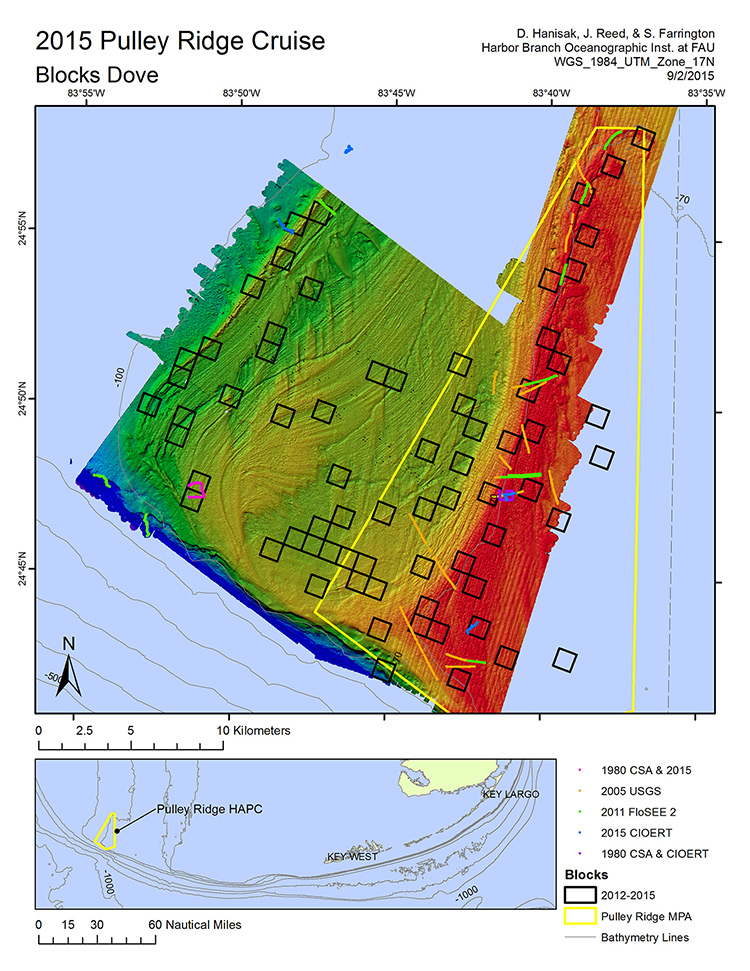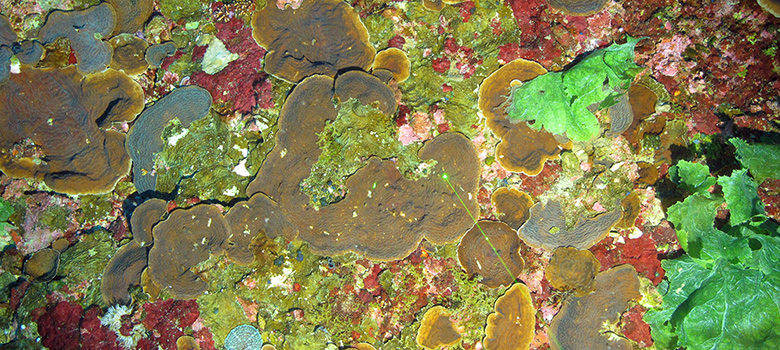
By M. Dennis Hanisak, Chief Scientist for the Coral Ecosystem Connectivity 2015 Cruise, and Research Professor - Florida Atlantic University - Harbor Branch
September 22, 2015
The video represents highlights from the Mohawk remotely operated vehicle dives from our fourth and final field season of scientific surveys of Pulley Ridge. Video credit: Coral Ecosystem Connectivity 2015 Expedition. Download (mp4, 39.0 MB).
We successfully concluded our fourth and final field season to investigate the role that the mesophotic coral ecosystems of Pulley Ridge (off the southwest coast of Florida) may play in replenishing key fish species, such as grouper and snapper, and other organisms in the downstream reefs of the Florida Keys and Dry Tortugas. Our team of 16 scientists and divers working on two ships, the R/V F.G. Walton Smith and the M/V Spree, accomplished all planned objectives for the 2015 field season. The data collected during this summer will be analyzed, along with the data collected from our 2012-2014 field seasons, to determine the connectivity of reef species living in Pulley Ridge to those of the Florida Keys and describe the structure of Pulley Ridge’s mesophotic communities. The results will then be provided to resource managers to enable development of more effective strategies to protect mesophotic reefs

Over four cruises, our Community Structure Team has crisscrossed Pulley Ridge in an effort to better assess its biological resources (corals, fish, sponges, algae). ROV surveys have been conducted in 69 1 km x 1 km blocks. Image courtesy of Coral Ecosystem Connectivity 2015 Expedition. Download larger version (jpg, 1.1 MB).
In 2014, we discovered a new coral area with large patches (up to 60 meters across) of nearly continuous plate coral (Agaricia spp.) near the main Pulley Ridge. Since it is not every day that you find a new coral area, we weren’t confident that we would be able to top last year’s finding, but we believe we came close.
This year, we decided to revisit (1) a site from 2012 that had a lot of coral to see how things had changed, as well as (2) the new coral area discovered in 2014 to get a better idea of its size.
After four years, what we found at the 2012 site was that things hadn’t changed much, which is great news. When comparing our 2012-2013 data to that collected earlier (1980-2003), we found there was a dramatic loss of coral cover at Pulley Ridge, approximately 92%. So, the fact that nothing has changed is a good thing and means that the ecosystem is stable.
Revisiting the site of our 2014 coral discovery, we conducted transects to get a better sense of the size of the coral area. Our preliminary findings estimate that the coral area is TWICE as large as we thought. The new area is full of small coral recruits (less than 10 cm in size), which means that there has been a recruitment event or series of events that are helping the ecosystem rebound after the dramatic loss.
On the Walton Smith, we:

The cruise’s major finding was that the new coral area discovered in 2014 was twice as large as we thought. Again, we found large areas of the plate coral Agaricia dominated by small recruits (10 cm or less in size). We believe this is indicative of a very significant recruitment during the last five years, following what is still an unexplained decline in corals at Pulley Ridge. Image courtesy of Coral Ecosystem Connectivity 2015 Expedition. Download larger version (jpg, 1.5 MB).
On the M/V Spree, we collected 336 specimens of targeted coral, fish, sponge, and algal species during the 10-day cruise to Pulley Ridge and the Tortugas. The Population Genetics group will use molecular tools to identify relationships among populations at these sites and other reefs in the Gulf of Mexico and the Florida Keys.
Our four field seasons have added a considerable amount of new information to what is known about Pulley Ridge and the Tortugas area. While only a few of us get the opportunity to go to sea, it is important to note that the project consists of a far larger group of scientists and technicians that are shore-based and without which this work would not be possible. In fact, over 35 scientists from 11 different academic institutions and three federal and state agencies are all working together to determine the connectivity of reef species living in Pulley Ridge to those downstream in the Florida Keys, and describe the community structure and determine the economic value of Pulley Ridge’s mesophotic communities. Additionally, a Stakeholder Advisory Board, consisting of federal, state, and nongovernmental stakeholders, are helping to guide the project’s outputs and ensure that they are useful to resource managers.